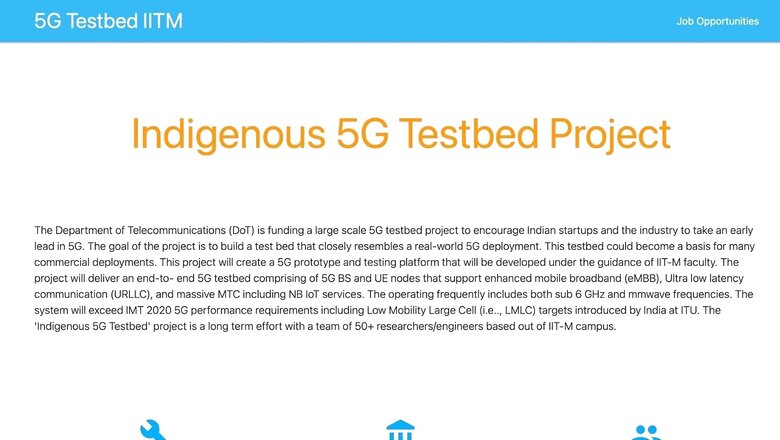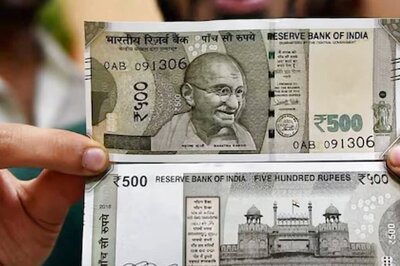
views
It is still just round the corner. In car racing terminology, this seems to be a rather long bend. We don’t really know how many apexes are still to be negotiated before 5G becomes a reality on your phone. After successful 5G tests, Reliance Jio and Bharti Airtel are confident that 5G services for consumers in India would become a reality sometime in the coming months, albeit with the small matter of the spectrum auction along the way. But there may just be a complication. It is called 5Gi, the localized version of 5G, a standard different from 5G standards used by networks globally. And compatible with the phones that you buy. The standard has been designed by IIT Madras, IIT Hyderabad and Centre of Excellence in Wireless Technology (CEWiT), emerging from an Indigenous 5G Testbed project, approved and funded by the Department of Telecommunications (DoT).
So, what really is 5Gi? The basic difference between 5Gi and the global 5G standards is that the former is designed to work on bands lower than the range of 5G bands otherwise. The global range standards for 5G networks are between 700MHz and 52,000MHz, there may be some sacrifice of range of connectivity at higher bands. These are further divided into low frequency brackets (less than 1GHz bands), medium frequency (1GHz to 6GHz bands) and high frequency (greater than 6GHz bands). India, like most 5G ready countries and mobile networks, is most active with tests in the medium frequency range. Mobile service providers in India have regularly referred to the 1.8GHz and 2.1GHz bands for coverage here. The 5Gi networks work on lower bands on the spectrum, the idea being to offer a wider coverage area with every 5G transmitter.
What Is The Complication? The 5Gi technology that is being tested works on the Low Mobility Large Cell method, with a cell based transmit waveform to increase the range. The Telecommunications Standards Development Society, India (TSDSI) has said, “Enhanced cell coverage enabled by this standard, will be of great value in countries and regions that rely heavily on mobile technologies for connectivity but cannot afford dense deployment of base stations due to lack of deep fibre penetration, poor economics and challenges of geographical terrain.” TSDSI had proposed the use of large cells as a mandatory 5G requirement back in 2017. This is to push mobile connectivity in rural areas as well as offer better coverage in high-density areas where network load and therefore slower than usual mobile data speeds, is often a concern.
Existing Technology May Already Have The Solution. The thing with the switch to large cell from the existing small cell hardware already in use for 4G and 5G networks globally, is that the small cells with tweaks to how they work, can deliver similar and even better results. Ericsson and Australian mobile network Telstra announced that they were able to extend the range of each cell in their 4G network to 200km. This is double the standard limit of 100km. This negates the need for new network infrastructure hardware acquisition and deployment. What cellular service providers in India are insisting is the need to standardise 5Gi in line with the global 5G standards and requirements, which would eliminate delays because of ecosystem incompatibility and limitations, as well as potential cost to customers whose phones may potentially not work with 5Gi.
Your Phone May Just Be Rendered 5G Incompatible. If mobile service providers adopt the 5Gi standard for 5G mobile networks in India, this may mean not only the need to buy spectrum for those lower frequencies for 5Gi to work, but also have phones and consumer devices that support those bands. Let us take the look at the example of the Xiaomi Redmi Note 10T 5G phone, priced just under Rs 15,000 in India. This phone supports the SA: N1, N3, N40, N77, N78 and NSA: N78 5G bands. The N1 band works at 2100MHz, N3 works at 1800MHz, N40 at 2300MHz, N77 at 3700MHz and N78 at 3500MHz. This is what mobile service providers are alluding to—the problem this will pose with most 5G phones that are already on sale in India, or in customers hands, may be rendered incompatible with 5Gi. And since band support is hardware enabled as well, a simple software update may not achieve the desired results either.
The Push For India’s Contribution to 5G. In May this year when telecom service providers including Reliance Jio, Bharti Airtel, Vodafone Idea and MTNL along with equipment manufacturers as well as technology providers including Samsung, Ericsson and Nokia were given approvals for 5G trials, the Ministry of Communications had mentioned the 5Gi technology as well. “The TSPs are encouraged to conduct trials using 5Gi technology in addition to the already known 5G Technology. It will be recalled that International Telecommunications Union (ITU) has also approved the 5Gi technology, which was advocated by India, as it facilitates much larger reach of the 5G towers and Radio networks,” the ministry had said at the time.
It was in November 2020 when the International Telecommunication Union (ITU) had said that 3GPP 5G-SRIT and 3GPP 5G-RIT submitted by the Third Generation Partnership Project (3GPP), and 5Gi submitted by Telecommunications Standards Development Society India achieved global validation after successful evaluation. “5Gi, the first ever Mobile Radio Interface Technology contribution from India to become part of ITU-R’s IMT recommendation, went through a rigorous evaluation process of the ITU-R working groups over the past 3 years before getting the approval,” TSDSI had said after the ITU approvals.
5G Tests And The March Towards 5G On Our Phones. Reliance Jio confirmed over the summer that the 5G technology trials in the field have been successful, with speeds over 1Gbps clocked, with the specific focus on 5G hardware and infrastructure developed in India. “Our ‘Made in India’ solution is comprehensive, complete and globally competitive. It reaffirms my faith in the abundant talent of Indian engineers to deliver world class products in such a cutting-edge technology. Recently, we received the necessary regulatory approvals… as well as trial spectrum for initiating 5G field-trials,” said Mukesh Ambani, chairman and managing director of Reliance Industries Ltd., during the company’s 44th Annual General Meeting.
Bharti Airtel also confirmed that the company clocked successful 5G trial with Nokia last month, clocking speeds of more than 1Gbps during the trials. They had earlier clocked similar trials in Hyderabad. The company says they have the capability to operate 5G networks on 1800 MHz, 2100 MHz, 2300 MHz as well as the 800 MHz and 900 MHz bands.
Read all the Latest News, Breaking News and Special: Live-updating IPL 2022 auction tally | IPL Mega Auction Live Updates here.




















Comments
0 comment